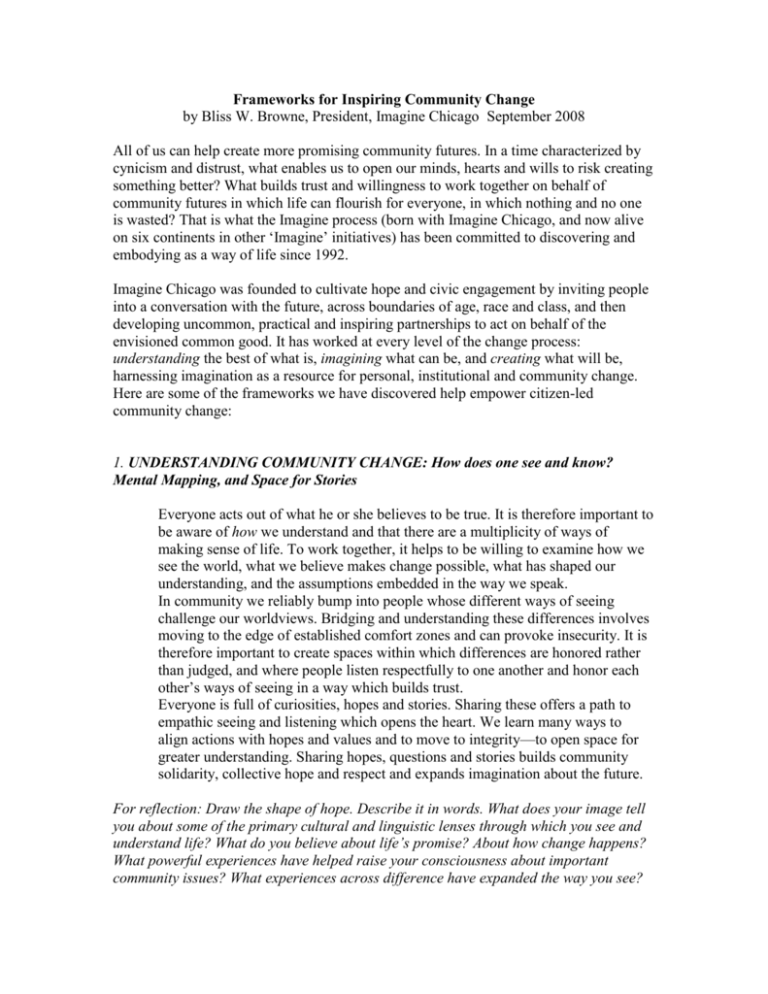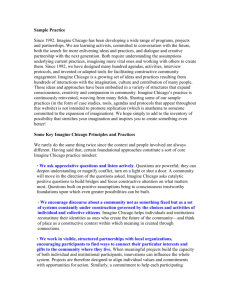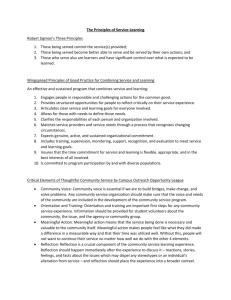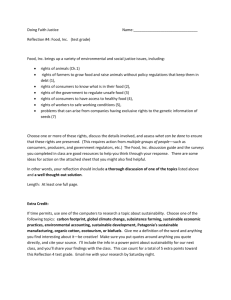Frameworks for Inspiring Community Change
advertisement

Frameworks for Inspiring Community Change by Bliss W. Browne, President, Imagine Chicago September 2008 All of us can help create more promising community futures. In a time characterized by cynicism and distrust, what enables us to open our minds, hearts and wills to risk creating something better? What builds trust and willingness to work together on behalf of community futures in which life can flourish for everyone, in which nothing and no one is wasted? That is what the Imagine process (born with Imagine Chicago, and now alive on six continents in other ‘Imagine’ initiatives) has been committed to discovering and embodying as a way of life since 1992. Imagine Chicago was founded to cultivate hope and civic engagement by inviting people into a conversation with the future, across boundaries of age, race and class, and then developing uncommon, practical and inspiring partnerships to act on behalf of the envisioned common good. It has worked at every level of the change process: understanding the best of what is, imagining what can be, and creating what will be, harnessing imagination as a resource for personal, institutional and community change. Here are some of the frameworks we have discovered help empower citizen-led community change: 1. UNDERSTANDING COMMUNITY CHANGE: How does one see and know? Mental Mapping, and Space for Stories Everyone acts out of what he or she believes to be true. It is therefore important to be aware of how we understand and that there are a multiplicity of ways of making sense of life. To work together, it helps to be willing to examine how we see the world, what we believe makes change possible, what has shaped our understanding, and the assumptions embedded in the way we speak. In community we reliably bump into people whose different ways of seeing challenge our worldviews. Bridging and understanding these differences involves moving to the edge of established comfort zones and can provoke insecurity. It is therefore important to create spaces within which differences are honored rather than judged, and where people listen respectfully to one another and honor each other’s ways of seeing in a way which builds trust. Everyone is full of curiosities, hopes and stories. Sharing these offers a path to empathic seeing and listening which opens the heart. We learn many ways to align actions with hopes and values and to move to integrity—to open space for greater understanding. Sharing hopes, questions and stories builds community solidarity, collective hope and respect and expands imagination about the future. For reflection: Draw the shape of hope. Describe it in words. What does your image tell you about some of the primary cultural and linguistic lenses through which you see and understand life? What do you believe about life’s promise? About how change happens? What powerful experiences have helped raise your consciousness about important community issues? What experiences across difference have expanded the way you see? * Briefly describe a positive change that you've been involved with in the community and something you learned about change. What do you consider your greatest strength as a community change agent? 2. MOTIVATING CHANGE: How does one cultivate hope and engagement? Encouraging the Expression of Creativity and Vision As human beings who long to belong and make a difference, we are both “pushed” into the future by events outside our control and “pulled” into the future by what inspires and motivates us. Inquiring about hopes, aspirations, dreams, vocation and commitments can bring deeply held values into public view and unleash energy and momentum for aligning values and action in a more meaningful direction. Sharing images and stories of hope, and inviting their expression through arts- based processes, liberate collective imagination and open up sources of inspiration. Listening to and respecting what gives meaning and purpose to one another’s lives and calls us forward can expand collective inspiration and willingness to act together. For reflection: Think for a moment about why people “do what they do?” What motivates and inspires you most right now? How is that evident in the choices you are making? * Think of a change you would especially like to see in your community. Why does it matter to you? In what contexts do you have the opportunity to express your vision for change and work with others on behalf of it? How can you connect what you want to what other people care about most? 3. LEARNING IN COMMUNITY: How do we learn together what no one yet knows? Opening the System with Appreciative Inquiry A key opportunity in community engagement is to ask questions that raise consciousness and inspire action . Every question leads somewhere. Communities move in the direction of what they ask about. Questions can shut down a system or open it up; they can be used to intimidate people or to inspire them. What questions would encourage others, expand understanding, clarify, invite and build community? What questions build bridges to positive experiences and hopes, stimulate reflection on issues of importance, help people notice what is of most value, and encourage sharing of ideas? How do we create forums in which such exchanges happen creatively and respectfully and lead to more balance and vitality in public life? For reflection: What sorts of questions do you tend to ask? Think of a question you would appreciate being asked that might help unlock your creativity…your commitment...your participation. What question is very much “alive” in you right now…a vivid curiosity or struggle, a growing edge in your learning about life? * What are the most important questions right now in your life, questions that represent your “learning edge”? What questions would you most like to see residents of your community asking one another? What questions do you feel are most important to ask right now and to discuss in order to open up a new conversation and way forward? 4. CONSTRUCTING COMMUNITY: What worlds do we create with our language? Strengthening Positive Communications A considerable challenge in building community is that so much public talk is problem and deficit oriented. Most of us have been trained to “think critically” by asking: “What’s the problem? What or who caused it, whose fault is it? What can we do about it?” Problem solving has limited utility in mobilizing community participation since people react negatively to being viewed and treated as problems to be solved. We react defensively because we sense ourselves being judged and under threat. To frame community regeneration in problem talk creates expertise and focus on what communities don’t want and what doesn’t work. To shift from deficit to visionary language opens up possibilities and energy for community renewal. Questions which help communities identify and name strengths, skills, hopes, values, assets and constructive ideas form a positive community image and identity which can inspire higher participation and attract investment. For Reflection: Think for a moment on the differences between deficit-based and assetbased community development or youth development approaches. Why do “needs and deficit mapping” lead to “services” as solutions; residents as consumers of services; managing the “system”; internalization of negative self-images; disempowered residents; resources directed to service providers; and cycles of dependency? Why do capacity inventories & asset mapping lead toward capacity-oriented programs/policies; local residents and institutions as assets of choice; local connections strengthened; community members investing themselves; development from the inside out; empowered residents; and new sources of capital and local control? *Given the habit of negative thinking in which many people’s thinking is trapped, how can you hold space for people's anger and frustration to be expressed but re-direct it to a constructive end that invites movement in the direction of something positive?? How can you help shift dominant frames in a more constructive direction? E. CONNECTING COMMUNITY: How do we strengthen partnerships? Expanding Collaboration When people work together across difference, more becomes possible and the likelihood of innovation increases. But many people live, some by choice, in segregated communities, with a resulting loss of imagination and connection. This can be as true of professional silos as it is of poor communities isolated by structural injustices. Productive partnerships can be difficult among people who hold limiting stereotypes of one another or among professionals who have been trained to think of themselves as experts with answers rather than as community partners with questions. What raises confidence that partnerships are worth running the risk of vulnerability, that a greater good can be accomplished than we can accomplish on our own? Talking together about what is of most value, inquiring about the core mission, strengths and purpose of the community or organization builds respect and invites collaboration. Partnerships with integrity enable participating organizations to accomplish their respective missions more effectively than they could otherwise achieve on their own. Sharing authentic questions establishes an identity for everyone as someone willing and eager to learn. Effective community partnerships require such a need and openness, a humility that no one has all the answers and that we can benefit from learning together. For Reflection: How and why do intergenerational, intercultural partnerships often expand innovation? *What are your best practices, skills, values, policies that make you prepared to work effectively in a partnership environment? What are the benefits and outcomes of forming strong partnerships? Why does working together make sense? If you wanted to establish a new partnership around some issue you care about, what are some of the most important factor that would help your partnerships thrive? F. LEADING COMMUNITY: How can we be the change we want to see? Actions speak louder than words. Where are the places in your life that it is most evident what you care about, where you have been able to influence others by your commitment? What are the areas in your life in which you feel your actions and values are best aligned? For Reflection: What have you discovered brings hope alive and encourages commitment? What inspires you to take constructive risks as a community builder? An Appreciative Inquiry into Community Change *What is a “high point” story of a time you were involved in a really “good” community effort-- something important and empowering—which got many people working together and made a difference that no one could have accomplished alone… What inspired you to get involved? What was most meaningful for you about your involvement? How did you work with others and what did you learn from them? What difference were you able to make and what resources, strengths and skills of yours did you have an opportunity to contribute? How did the project strengthen you and others? How did it make good use of people’s skills, resources and abilities? What were some of the challenges of working together and how did you address them? What did you learn about how positive community change happens? What do you now see as possible as a result? What is one change you would most like to see in your own community and something you might use AI to do to help make it happen? For more examples of practice, please visit www.imaginechicago.org Some simple AI questions for reflection: What do you value most about yourself as a community builder? about the community of which you are a part? What small changes in your life/in your community do you feel could make a big difference? What would most encourage you to make them?





